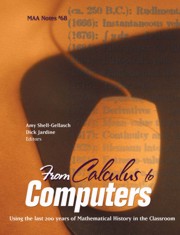Book contents
- Frontmatter
- Preface
- Contents
- Introduction
- I Algebra, Number Theory, Calculus, and Dynamical Systems
- II Geometry
- III Discrete Mathematics, Computer Science, Numerical Methods, Logic, and Statistics
- 9 Using 20th Century History in a Combinatorics and Graph Theory Class
- 10 Public Key Cryptography
- 11 Introducing Logic via Turing Machines
- 12 From Hilbert's Program to Computer Programming
- 13 From the Tree Method in Modern Logic to the Beginning of Automated Theorem Proving
- 14 Numerical Methods History Projects
- 15 Foundations of Statistics in American Textbooks: Probability and Pedagogy in Historical Context
- IV History of Mathematics and Pedagogy
- About the Authors
10 - Public Key Cryptography
from III - Discrete Mathematics, Computer Science, Numerical Methods, Logic, and Statistics
- Frontmatter
- Preface
- Contents
- Introduction
- I Algebra, Number Theory, Calculus, and Dynamical Systems
- II Geometry
- III Discrete Mathematics, Computer Science, Numerical Methods, Logic, and Statistics
- 9 Using 20th Century History in a Combinatorics and Graph Theory Class
- 10 Public Key Cryptography
- 11 Introducing Logic via Turing Machines
- 12 From Hilbert's Program to Computer Programming
- 13 From the Tree Method in Modern Logic to the Beginning of Automated Theorem Proving
- 14 Numerical Methods History Projects
- 15 Foundations of Statistics in American Textbooks: Probability and Pedagogy in Historical Context
- IV History of Mathematics and Pedagogy
- About the Authors
Summary
Introduction
When teaching mathematics to computer science students, it is natural to emphasize constructive proofs, algorithms, and experimentation. Most computer science students do not have the experience with abstraction nor the appreciation of it that mathematics students do. They do, on the other hand, think constructively and algorithmically. Moreover, they have the programming tools to experiment with their algorithmic intuitions.
Public-key cryptographic methods are a part of every computer scientist's education. In public-key cryptography, also called trapdoor or one-way cryptography, the encoding scheme is public, yet the decoding scheme remains secret. This allows the secure transmission of information over the internet, which is necessary for e-commerce. Although the mathematics is abstract, the methods are constructive and lend themselves to understanding through programming.
The mathematics behind public-key cryptography follows a journey through number theory that starts with Euclid, then Fermat, and continues into the late 20th century with the work of computer scientists and mathematicians. Public-key cryptography serves as a striking example of the unexpected practical applicability of even the purest and most abstract of mathematical subjects.
We describe the history and mathematics of cryptography in sufficient detail so the material can be readily used in the classroom. The mathematics may be review for a professional, but it is meant as an outline of how it might be presented to the students. “In the Classroom” notes are interspersed throughout in order to highlight exactly what we personally have tried in the classroom, and how well it worked.
- Type
- Chapter
- Information
- From Calculus to ComputersUsing the Last 200 Years of Mathematics History in the Classroom, pp. 109 - 124Publisher: Mathematical Association of AmericaPrint publication year: 2005



